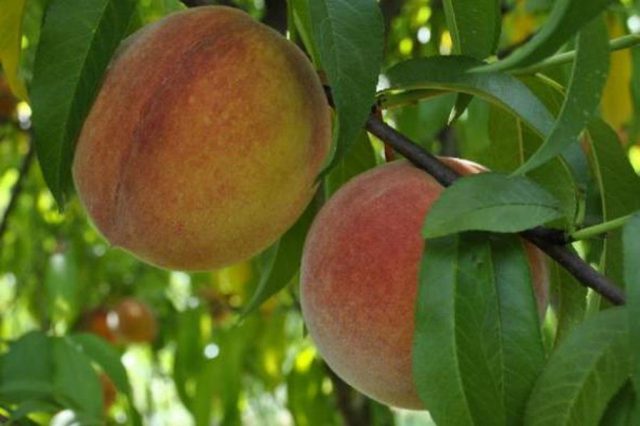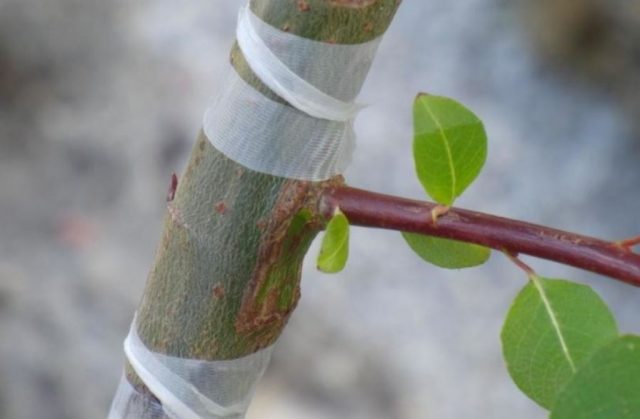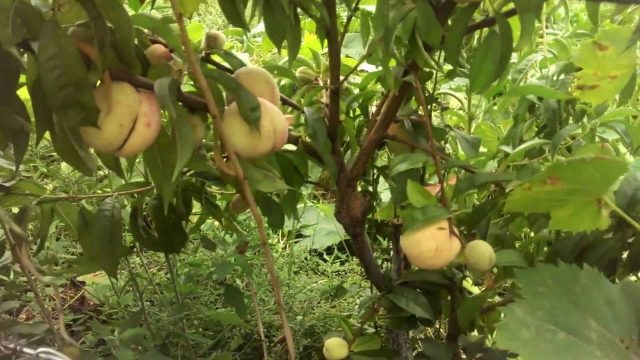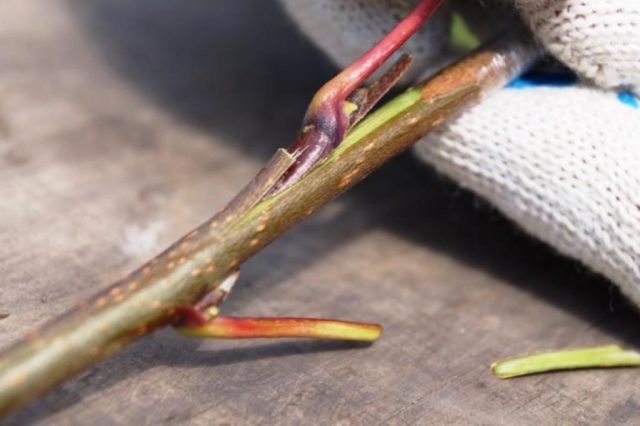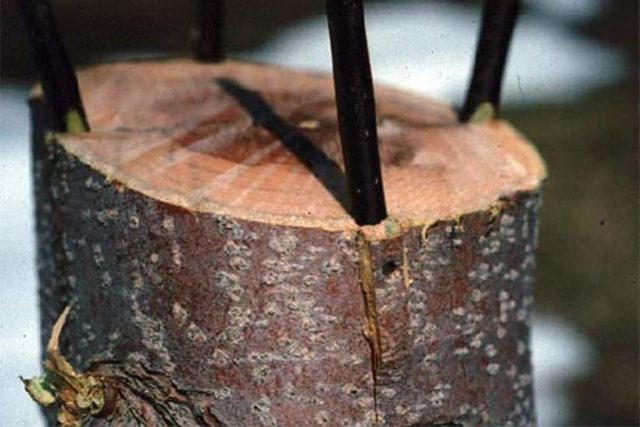Content
- 1 Why do you need to plant peaches
- 2 Peach inoculation timing
- 3 Preparation of tools and materials
- 4 What can you plant a peach on
- 5 Scion preparation
- 6 Peach grafting by budding method
- 7 How to plant a peach by copulating
- 8 Peach grafting for the bark
- 9 How to properly plant a peach "in the cleft"
- 10 Caring for grafted peaches
- 11 Conclusion
Peach is a thermophilic plant that is difficult to grow in regions with cold winters. But grafting a peach on a fruit tree can solve the problem, make it whiter, cold-resistant with maximum fruiting. Everyone can master the vaccination technique, the main thing is to purchase sharp instruments and strictly follow the instructions.
Why do you need to plant peaches
Vaccination is one way of propagating a peach. Thanks to this procedure, you can harvest a rich, high-quality crop, increase frost resistance, resume fruiting and preserve rare varieties.
If the plot is small, several varieties are grafted onto one scion. This will allow you to grow a tree that will yield a variety of flavors.
Peach grafting is a long and interesting activity, it requires from gardeners not only precise movements, but also compliance with the rules of execution. For the vaccination to be successful, you need to know the timing, time, choose the right stock and study the existing methods.
Valuable peach varieties can be propagated by green cuttings. This method is suitable for obtaining self-rooted seedlings. Young cuttings are rooted in a nutritious soil. The container is filled with prepared soil, the top is covered with sand. The stalk is processed in the preparation "Kornevin" or "Epin" and planted at an acute angle. To create a favorable microclimate, the container is covered with a glass jar. In the process of rooting, regular irrigation and airing are carried out.
However, most gardeners propagate the peach in the garden by grafting.
There are several ways to graft a peach:
- copulation;
- budding;
- into cleavage;
- for the bark.
Peach inoculation timing
Vaccination can be done at any positive temperature. The timing depends on the region, the age of the tree and the method chosen.
In the spring, peach grafting is done by budding and copulating. Agronomists consider spring to be the best time, as the weather and sap flow will help restore wounds after surgery in the shortest possible time.
The spring grafting is carried out during the swelling of the kidneys, after the air warms up to + 8 ° C, since the subzero temperature will lead to the rejection of the grafted cuttings.
Peach inoculation in the summer is carried out by budding in the crown. The healing process takes about a month. Gardeners distinguish 2 categories of summer vaccination:
- early summer - the beginning of June;
- summer - from 10 to 30 July.
Autumn grafting is recommended in regions with a warm climate. In cities with unstable weather, the scion will not have time to take root and will freeze out with 100% probability during the first frosts.
Preparation of tools and materials
The vaccine must be done the first time. To obtain a positive result, the cuts must be flat, free from defects and jaggedness. Therefore, it is necessary to prepare sterile and very sharp instruments. The following tools are used for vaccination:
- secateurs;
- knife;
- garden saw.
Also at hand should be: glue, plastic wrap, electrical tape, garden var, bandage and newspaper. The newspaper is needed for vaccinations in the summer.It will save the vaccination site from direct sunlight.
What can you plant a peach on
The best stock is peaches of hardy varieties. By combining several valuable varieties, you can grow a rare, high-yielding species with large, tasty fruits.
Also suitable as a stock:
Apricot - shows high survival rates, therefore it is suitable for inexperienced gardeners. Scion strengths:
- good fruiting;
- high survival rate;
- lack of influx.
Plum - it is used as a rootstock if the peach is grown in regions with changeable weather. Strong, cold-resistant varieties are suitable for the stock.
Cherry plum is an ideal stock. On its basis, the peach tree acquires immunity to fungal diseases, and ripe peaches acquire an unusual taste. This rootstock has one drawback - root growth. If not removed in a timely manner, it will take a lot of strength from the tree, which will lead to a decrease in yield.
Almonds - This stock is only suitable for southern regions. Such a grafted peach can only grow and bear fruit in warm weather.
Blackthorn and felt cherry - gardeners claim that by taking these trees as a rootstock, you can grow a bushy peach tree of compact size. But so that the flexible branches do not break during fruiting, it is necessary to install supports.
Clonal peach rootstocks are also suitable for grafting, which will have good compatibility, and they will not have a negative effect:
- Spring flame - a hybrid of the Chinese plum and cherry plum. The stock is medium-sized, frost-resistant, suitable for southern and middle regions.
- Kuban-86 - semi-dwarf rootstock with well-developed roots and immunity to nematodes.
- VVA-1 - a hybrid of cherry plum and plum. The stock is drought and frost-resistant.
- Speaker - a hybrid of cherry plum and cherry plum, which is suitable for growing in the Central region of Russia. The variety is highly resistant to disease.
- VSV-1 - a hybrid of cherry plum and felt cherry. The stock grows well on moist soil, is resistant to diseases, frost-resistant, can grow in all regions of Russia.
Is it possible to graft a peach on an apricot
Peach and apricot are very similar crops. Therefore, apricot is considered an ideal rootstock for peach, as many varieties are cold-hardy and can grow in any soil. The best time to graft a peach on an apricot is in the spring and summer. If the vaccination is done in the spring, it is necessary to wait until the end of the frost, and cover the vaccination site with polyethylene. Summer vaccination is carried out from early June to mid-July.
The best varieties for rootstock:
- Veteran;
- Juicy;
- Greensboro;
- Redhaven.
When grafted onto an apricot, a peach will bear early fruiting and strong growth. The growing season ends early, which allows the plant to mature well and safely endure the coming cold weather. Any method you like is suitable for grafting on an apricot.
Is it possible to plant a peach on a plum
Grafting a peach on a plum makes it possible to retain the varietal qualities of the peach. Since the plum is unpretentious, resistant to diseases and tolerates severe winters well, and the peach tree grows strong, healthy and well-fertile.
2 types of plums are suitable for the stock:
- Hungarian Donetsk;
- Hungarian Italian.
Benefits of grafting peach on peach
Peach is the best graft for a peach. By combining different varieties, you can grow a high, unique harvest with good taste.
Using a peach as a scion, it must be remembered that heavy, alkaline soil is not suitable for such a rootstock. Positive qualities include durability, low risk of drying out and lack of root growth. The weak side of the scion: low drought and frost resistance.
Today, gardeners use 2 types of rootstock: generative and vegetative. Peach generative propagation is carried out by germinating seeds. With proper care, 1 rootstock grows from one seed.
Propagation of a peach by cuttings (vegetative method) to obtain a quality rootstock allows you to get an improved variety and harvest a generous harvest of tasty and large fruits. According to gardeners, the best rootstock for a peach is a grown seedling from a varietal cuttings.
Peach compatibility with other fruit trees
Peach grafting can be practiced on any fruit crop, but few are considered the best. Before vaccination, you need to choose the strongest and healthiest specimens and know what outcome can be expected.
In addition to plum, peach and apricot, you can consider other options:
- Almond - used in warm cities. This is a strong, vigorous tree, so the peach is ideal. Any variety can be grafted onto almonds. With the correct manipulation, the yield will increase 2 times.
- Cherry plum Is an ideal rootstock suitable for backyards with heavy, waterlogged soil. The shape of the peach will be bushy, making harvesting easier. With the timely removal of root shoots, fruiting occurs early, annually and abundantly. Certain varieties of peach can be grafted onto cherry plum, such as Kievsky and Superearly.
- Felted cherry - when using this rootstock, the peach tree grows undersized, but frost-resistant. During fruiting, flexible shoots need support, otherwise the branches will break before the fruits are fully ripe. The rootstock has one drawback - the peach will often suffer from moniliosis.
- Thorn - it is possible to grow a low-growing, cold-resistant shrub that will bear fruit stably. For the fruits to be tasty and large, it is necessary to regularly remove the pre-root shoots.
Scion preparation
Suitable for the stock are 2 summer shoots without flower buds, about half a meter long. They are cut in the fall, after leaf fall, from the southern part of the crown. In weakened, thin shoots, the survival rate is low, so cuttings with a diameter of 5-10 mm are suitable for the scion. It is better to cut them from a healthy tree in the morning or evening.
The cut cuttings are tied, wrapped in a damp cloth, placed in a plastic bag and placed in a refrigerator or basement, where the air temperature will not exceed + 2 ° C. In well-preserved cuttings, the wood should be smooth and the buds not deformed. Before grafting, it is better to check the viability of the scion, if it bends and does not break, then it is suitable for subsequent work.
Peach grafting by budding method
Budding is a successful method to produce a healthy and fruitful tree. It is necessary:
- to increase frost resistance;
- to obtain high-quality, varietal peaches;
- for early fruiting.
Budding can be carried out in the stock and in the crown of the rootstock.
Butt grafting is suitable for young seedlings. The method is difficult, so it is not suitable for an inexperienced gardener. Execution technique:
- A shield 3 cm long is made on the handle, leaving one bud in the center.
- On the rootstock, remove the bark 3 cm long.
- The shield is applied to the incision in the rootstock and fixed with electrical tape.
- After a month, the retainer is removed, the junction of the rootstock and the scion is treated with garden varnish.
T-shaped budding in the crown of the scion - this method is used in the spring, when the air temperature warms up to + 8 ° C. The sequence of the vaccination:
- A vertical and horizontal bark incision is made on the rootstock.
- A bud with a base is cut from the scion.
- A kidney is inserted into the bark incision and the upper part is cut off.
- Above and below the vaccination site is fixed with a film.
How to plant a peach by copulating
Vaccination is carried out in early spring. The method is simple to execute and does not require a lot of effort and time. Execution method:
- the stalk and rootstock must be of the same length along the length;
- the vaccination site is disinfected and a cut is made at an angle of 45 °;
- a similar cut is made on a handle under the lower kidney;
- connect 2 fragments and fix with electrical tape;
- the junction is covered with garden pitch.
Peach grafting for the bark
This method is used to rejuvenate the tree. For this:
- the trunk or stem branch is cut off, the cut site is cleaned;
- a vertical incision 6 cm long is made on the rootstock and the bark is carefully separated for better entry of the cutting;
- make an oblique cut on the handle;
- peach scion is inserted behind the bark and fixed with polyethylene or electrical tape.
How to properly plant a peach "in the cleft"
Split grafting is a simple and popular method that has many advantages:
- ideal - it can be used with the same and different diameters of the rootstock and scion;
- 100% survival rate;
- easy to execute.
Vaccination is carried out in the spring at the time of swelling of the kidneys. Vaccination technique:
- Stock preparation and splitting - the stock selected for the stock is cleaned of dirt and old bark. If the diameter of the stock is small, an incision is made with a sharp knife to a depth of 3-4 cm. To prevent the split from closing, a wedge is inserted into it.
- Preparation of the scion - a wedge-shaped cut 3-5 cm long is made on the prepared cutting. The bare wood should not be touched with your hands, as this can lead to the addition of infections.
- Rootstock and scion joints - the prepared cutting is introduced into the split so that the cambial layers converge. The vaccination site is tied with cling film, open places are covered with garden varnish. Until the buds open, in order to maintain air humidity, the vaccination site is covered with a transparent plastic bag.
Caring for grafted peaches
The fixing bandage is removed 30 days after the vaccination, and the cut site is treated with garden varnish. Even if the cutting has taken root, further growth, development and fruiting depends on compliance with the rules of care. Peach is an unpretentious tree, but it is necessary to follow agrotechnical rules with full responsibility:
- Watering is carried out every 14 days, as the top layer of the soil dries out. In order for the root system to receive a sufficient amount of moisture, 10-15 liters of water are consumed for each plant.
- Often, shoots begin to form at the vaccination site, which must be disposed of in a timely manner. Otherwise, the tree will start spending energy on the development of the root system, instead of building up green mass, flowering and fruiting.
- It is necessary to regularly inspect the peach, since after grafting the tree is weakened, and diseases and insect pests can join it. Prevention is best carried out in the morning and evening, using folk remedies and disinfectant solutions.
Conclusion
Peach grafting is fun and easy. Observing the timing, technique and choosing the right tree for the stock, you can easily grow a peach tree even in regions with an unstable climate.
